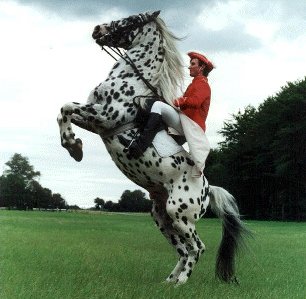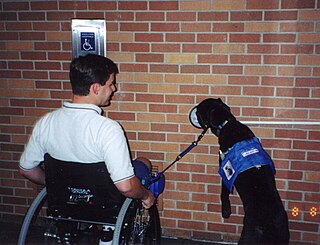
A phobia is an anxiety disorder, defined by an irrational, unrealistic, persistent and excessive fear of an object or situation. Phobias typically result in a rapid onset of fear and are usually present for more than six months. Those affected go to great lengths to avoid the situation or object, to a degree greater than the actual danger posed. If the object or situation cannot be avoided, they experience significant distress. Other symptoms can include fainting, which may occur in blood or injury phobia, and panic attacks, often found in agoraphobia and emetophobia. Around 75% of those with phobias have multiple phobias.

Animal training is the act of teaching animals specific responses to specific conditions or stimuli. Training may be for purposes such as companionship, detection, protection, and entertainment. The type of training an animal receives will vary depending on the training method used, and the purpose for training the animal. For example, a seeing eye dog will be trained to achieve a different goal than a wild animal in a circus.

Longeing or lungeing is a technique for training and exercising horses. It is also a critical component of the sport of equestrian vaulting.
Systematic desensitization, or graduated exposure therapy, is a behavior therapy developed by the psychiatrist Joseph Wolpe. It is used when a phobia or anxiety disorder is maintained by classical conditioning. It shares the same elements of both cognitive-behavioral therapy and applied behavior analysis. When used in applied behavior analysis, it is based on radical behaviorism as it incorporates counterconditioning principles. These include meditation and breathing. From the cognitive psychology perspective, cognitions and feelings precede behavior, so it initially uses cognitive restructuring.
On Horsemanship is the English title usually given to Περὶ ἱππικῆς, peri hippikēs, one of the two treatises on horsemanship by the Athenian historian and soldier Xenophon. Other common titles for this work are De equis alendis and The Art of Horsemanship. The other work by Xenophon on horsemanship is Ἱππαρχικὸς, hipparchikos, usually known as Hipparchicus, or The cavalry commander. The title De re equestri may refer to either of the two.

Horse training refers to a variety of practices that teach horses to perform certain behaviors when commanded to do so by humans. Horses are trained to be manageable by humans for everyday care as well as for equestrian activities, ranging anywhere from equine sports such as horse racing, dressage, or jumping, to therapeutic horseback riding for people with disabilities.

Rearing occurs when a horse or other equine "stands up" on its hind legs with the forelegs off the ground. Rearing may be linked to fright, aggression, excitement, disobedience, non experienced rider, or pain. It is not uncommon to see stallions rearing in the wild when they fight, while striking at their opponent with their front legs. Mares are generally more likely to kick when acting in aggression, but may rear if they need to strike at a threat in front of them.

The Finisterre universe is a fictional universe created by American science fiction and fantasy author C. J. Cherryh. Currently, it comprises a series of two science fiction / horror novels written by Cherryh, Rider at the Gate (1995) and Cloud's Rider (1996), also known as The Rider Series. They were published by Warner Books in the US and Hodder & Stoughton in the United Kingdom. The series is about the descendants of lost colonists stranded many generations ago on the hostile planet of Finisterre. For continuity, the two novels should be read in publication sequence.

Horse behavior is best understood from the view that horses are prey animals with a well-developed fight-or-flight response. Their first reaction to a threat is often to flee, although sometimes they stand their ground and defend themselves or their offspring in cases where flight is untenable, such as when a foal would be threatened.

Bucking is a movement performed by an animal in which it lowers its head and raises its hindquarters into the air while kicking out with the hind legs. It is most commonly seen in herbivores such as equines, cattle, deer, goats, and sheep. Most research on this behavior has been directed towards horses and cattle.
Cynophobia is the fear of dogs and canines in general. Cynophobia is classified as a specific phobia, under the subtype "animal phobias". According to Timothy O. Rentz of the Laboratory for the Study of Anxiety Disorders at the University of Texas, animal phobias are among the most common of the specific phobias and 36% of patients who seek treatment report being afraid of dogs or afraid of cats. Although ophidiophobia or arachnophobia are more common animal phobias, cynophobia is especially debilitating because of the high prevalence of dogs and the general ignorance of dog owners to the phobia. The Diagnostic and Statistical Manual of Mental Disorders (DSM-IV-TR) reports that only 12% to 30% of those with a specific phobia will seek treatment.
In psychology, desensitization is a treatment or process that diminishes emotional responsiveness to a negative, aversive, or positive stimulus after repeated exposure. Desensitization can also occur when an emotional response is repeatedly evoked when the action tendency associated with the emotion proves irrelevant or unnecessary. The process of desensitization was developed by psychologist Mary Cover Jones and is primarily used to assist individuals in unlearning phobias and anxieties. Desensitization is a psychological process where a response is repeatedly elicited in circumstances where the emotion's propensity for action is irrelevant. Joseph Wolpe (1958) developed a method of a hierarchal list of anxiety-evoking stimuli in order of intensity, which allows individuals to undergo adaptation. Although medication is available for individuals with anxiety, fear, or phobias, empirical evidence supports desensitization with high rates of cure, particularly in clients with depression or schizophrenia. Wolpe's "reciprocal inhibition" desensitization process is based on well-known psychology theories such as Hull's "drive-reduction" theory and Sherrington's concept of "reciprocal inhibition." Individuals are gradually exposed to anxiety triggers while using relaxation techniques to reduce anxiety. It is an effective treatment for anxiety disorders.

Service animals are working animals that have been trained to perform tasks that assist disabled people. Service animals may also be referred to as assistance animals or helper animals depending on the country and the animal's function. Dogs are the most common service animals, having assisted people since at least 1927.
Bolting, when referring to equids, generally refers to two equine behaviors, both undesirable:

Thalassophobia is the persistent and intense fear of deep bodies of water, such as the ocean, seas, or lakes. Though very closely related, thalassophobia should not be confused with aquaphobia, which is classified as the fear of water itself. Thalassophobia can include fears of being in deep bodies of water, the vastness of the sea, sea waves, aquatic animals, and great distance from land.

A lead, lead line, lead rope (US) or head collar rope (UK), is used to lead an animal such as a horse. Usually, it is attached to a halter. The lead may be integral to the halter or, more often, separate. When separate, it is attached to the halter with a heavy clip or snap so that it can be added or removed as needed. A related term, lead shank or lead chain refers to a lead line with a chain attached that is used in a variety of ways to safely control possibly difficult or dangerous horses if they will not respond to a regular lead.
Dog noise phobia, along with dog noise anxiety, are terms sometimes used by dog owners and veterinarians to describe canine fear of, and the corresponding stress responses to, loud noises.
John Lyons is an American horse trainer in the field of natural horsemanship. Lyons has been presenting training clinics and horsemanship symposia since 1980, has written several books on horses and horse training, and is the founder of John Lyons' Perfect Horse magazine. He lives and works out of Parachute, Colorado.

Separation anxiety in dogs describes a condition in which a dog exhibits distress and behavior problems when separated from its handler. Separation anxiety typically manifests within minutes of departure of the handler. It is not fully understood why some dogs suffer from separation anxiety and others do not. The diagnosis process often leads to a misdiagnosis as it is difficult to differentiate from other medical and behavioral problems. The behavior may be secondary to an underlying medical condition. With chronic stress, impairments to physiological health can manifest. Increased stress in the dog alters hormone levels, thus decreasing natural immunity to various health problems.

Thunder is the stage name for the horse who is the official live animal mascot for the Denver Broncos football team. Thunder shares mascot duties with Miles, a human who wears a horse head mask atop a Broncos uniform.













